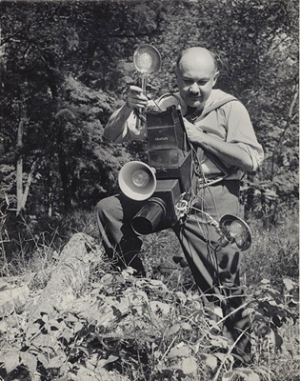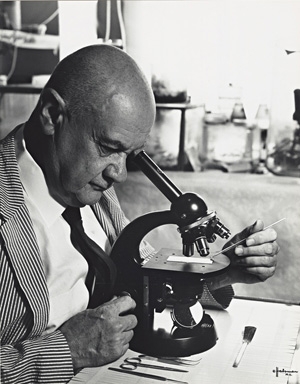Roman Vishniac
Roman Vishniac (1897–1990) was born in Leningrad (present-day Saint Petersburg) and raised in Moscow. As a young man, he was fascinated by microscopes and photography. This budding interest was realized in his lifelong work as a groundbreaking photomicroscoper. Yet, his greatest photographic legacy was as a "concerned photographer," especially his documentation of Jewish communities of Eastern Europe on the brink of World War II.
In 1920, Vishniac immigrated to Berlin. There he married his first wife Luta, with whom he had two children, Wolf and Mara. In 1935, Vishniac was commissioned by the American Joint Distribution Committee (JDC) in Central Europe to photograph Jewish communities in Eastern Europe as part of a fund-raising drive to help support these poor communities. After this initial trip, he returned to Berlin, where with the assistance of his young daughter, he developed his pictures in a darkroom in his apartment, drying them on his living room floor. Between 1935 and 1938, at the behest of the JDC, he traveled east on photo expeditions several more times, taking with him two cameras, a Rolleiflex and a Leica.
As life became increasingly difficult for Jews in Germany in the late 1930s, the fate of both the Vishniac family and Roman's precious negatives hung in the balance. Vishniac entrusted his negatives to a friend, Walter Bierer, who promised to try to curry them out of Europe. Within days of this exchange, Vishniac was arrested in Paris and interned in Camp Du Ruchard, a detention camp near Gurs.
Meanwhile, Luta struggled to obtain a U.S. visa and an affidavit of support from an American citizen, which would help to secure Vishniac's release. Finally, at the end of November 1940, after all of Luta's hard work, a visa was granted and Vishniac was freed. The family reunited in Lisbon, where they awaited passage to the United States and safety. They arrived in America on New Year's Eve, 1940.
The fate of Roman's negatives was more complicated. Walter Bierer carried them with him to Cuba, where he was interned for six months. When he finally obtained an American visa, and arrived in Miami, the negatives were confiscated by U.S. Customs officers, but they were later released to Vishniac in New York.
In New York, Vishniac endeavored to exhibit his images of impoverished Eastern European Jews on the brink of destruction. In 1943, he arranged for a small show at the Teachers College of Columbia University and wrote a letter to Eleanor Roosevelt inviting her to visit the exhibition. At this time he also worked as a portraitist to support his family, capturing well-known images of famous Jewish figures, including Marc Chagall and Albert Einstein. Over the next decades, he taught and lectured widely, and his microphotographs and science images appeared in leading magazines including LIFE. His son, Prof. Wolf Vishniac died in the Antarctic in 1973, and at the time of his death in 1990, Vishniac was survived by his former wife Leah (Luta), his second wife, Edith, and his daughter Mara Vishniac Kohn.

